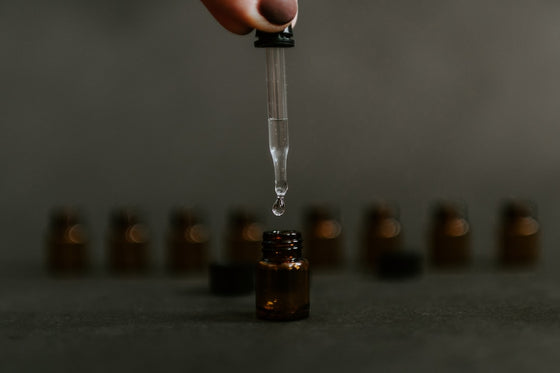Tea tree oil, sometimes called Melaleuca oil, is a component of the Melaleuca alternifolia tree, a native tree to Australia. It is most commonly used to treat acne, but many people use tea tree essential oil as a household cleaner. Tea tree oil is popular because it is both practical and all-natural. This blog post will look at tea tree oil for acne.
What is tea tree oil, and what are its uses for acne
Tea tree oil, also known as melaleuca oil, has been used for medicinal purposes for hundreds of years. It's made by steam distilling the leaves of the tea tree, which is native to Australia. Tea tree oil has numerous health benefits. Many people use it to kill bacteria and fight infections. And some people use it for skin problems. But it's commonly used for skincare products.
Pure Tea tree oil contains antiseptic, anti-inflammatory and antimicrobial properties, readily absorbed by the skin. It's commonly used for skincare and treating acne because of its powerful antibacterial properties.
The oil kills the bacteria that cause acne, including Propionibacterium acnes - the bacterium that causes acne. Tea tree oil can also cause redness and swelling, which helps to reduce acne-prone skin.
It's also used to treat other skin conditions, such as psoriasis, dandruff, eczema, and athlete's foot.
Tea tree oil may cause skin irritation in some people, especially if you're sensitive to any ingredients. It's also been reported to cause drowsiness.
Always use tea tree oil in small amounts because more significant parts of the oil may irritate. Never apply it to broken skin. Always consult a doctor before using tea tree oil to treat a condition, especially if you have diabetes, skin disorders, autoimmune disease, or cancer.
How to use tea tree oil for acne - step by step
Tea tree oil has many uses, including treating acne. You can use it to treat existing acne, help to prevent acne, and as a daily cleanser to prevent new acne.
Tea tree oil is antibacterial, antifungal, and even anti-viral. Applying a drop of tea tree oil to your skin can kill off bacteria that cause acne and prevent it from returning.
Step 1: Wash your face with soap or your favourite facial cleanser and water and dry it.
Step 2: Mix three drops of tea tree oil with three drops of water, olive oil or your favourite carrier oil.
Step 3: Apply a thin mixture layer onto your face using a cotton swab. Let it soak in for 20 minutes, then rinse it off. Please do not leave it on for more than 20 minutes, or it may cause skin irritation.
Step 4: Repeat step 3 twice daily until you notice an improvement in your pimples.
Step 5: Tea tree oil is a drying oil, so use it sparingly. Do not apply to sensitive skin.
What to avoid when using tea tree oil for pimples breakout?
Tea tree oil is a natural product from the leaves of the tea tree plant. The oil has many benefits, including preventing and treating acne. However, there are three things to avoid when using tea tree oil for pimples:
1. Using too much oil - Tea tree oil has a powerful smell, which makes it easy to overuse. In addition, too much tea tree oil can cause skin irritation, primarily when used on sensitive skin.
2. Using tea tree oil on broken skin - Tea tree oil can dry out your skin, which makes the skin more susceptible to acne. In addition, if the skin is irritated, damaged, or infected, tea tree oil can worsen the problem. For those with sensitive skin, tea tree oil can worsen acne because the skin will be susceptible to irritation and inflammation.
3. Apply tea tree oil to your face before cosmetics - Tea tree oil is oil. Oil can interfere with all other skin care products. It's best not to apply tea tree oil to your face until you've used all your other skin care products, including your moisturizer.
Results of using tea tree oil for acne
According to studies, using tea tree oil for pimples can be very effective. He reports that tea tree oil has antibacterial properties and can effectively treat staphylococcus, a common bacteria on the face that causes acne.
When tea tree oil is diluted with water, it can help heal damaged skin and reduce spots and acne. Tea tree oil applied directly to the face can also reduce astringent.
Tea tree oil is safe to use when used as an acne treatment. As a general rule, do not ingest tea tree oil, but it is safe to apply to the skin.
Tea tree oil is a plant-based oil that has been very effective in treating skin conditions when used correctly. When diluted with water, it can be applied directly to the skin. Tea tree oil can also be used on the skin to reduce the appearance of scars.
Be sure to use tea tree oil from 100% pure, organic tea tree oil.
Frequently Asked Question
What are the benefits of using tea tree oil for pimples?
Tea tree oil contains an ingredient known as terpinen-4-ol, which kills the bacteria that causes acne. These bacteria are Propionibacterium acnes (P. acnes) and Staphylococcus epidermidis (S. epidermidis). It also contains other ingredients that help fight acne, such as:
- terpinen-4-ol - Kills acne-causing bacteria
- cineole - Helps reduce inflammation
- linalool - Helps reduce inflammation
- d-Limonene - Helps fight bacteria
- Eucalyptol - Helps fight bacteria
- citronellol - Helps fight bacteria
- alpha-pinene - Helps fight bacteria
Tea tree oil can be used to prevent acne or treat existing acne. When used religiously, tea tree oil can clear acne quickly. It comes in many forms, including cream, lotion, gel, and cleanser.
What critical ingredients in tea tree oil make it an effective acne treatment?
Tea tree oil is made from the leaves of the Melaleuca alternifolia tree, which is found in the coastal regions of Australia. It's commonly used to treat pimples and acne because it's antifungal and anti-microbial. Tea tree oil's anti-microbial properties can help it reduce the bacteria on your skin, reducing oil production on your face.
Tea tree oil has many other potential health benefits. It can reduce inflammation, fight the common cold, and alleviate muscle pain. However, it's not recommended for use internally or with children.
How do I use tea tree oil for acne?
Applying tea tree oil to your skin can irritate, so first dilute it.
To make a 3% tea tree oil solution:
- Use 1/3 cup of melaleuca oil to 2/3 cup of water.
- Pour a few drops of the solution into a spray bottle and mist your face.
- For oily skin, use less water.
You can also apply tea tree oil with a cotton ball. Dab it on your oily areas one to three times daily. Don't apply it to broken skin.
Using tea tree oil doesn't eliminate acne but can kill the bacteria that cause acne. It can also help reduce the amount of oil your skin produces.
What are the risks associated with using tea tree oil for acne?
The use of tea tree oil may have several benefits for acne. First, tea tree oil has been shown to have antibacterial and antifungal properties, which makes it ideal for acne spot treatment.
Acne is commonly associated with redness, itching, dryness, peeling, and infection. However, tea tree oil may help alleviate some of these symptoms.
Tea tree oil is applied directly to acne and kills the bacteria that cause the infection. It can also reduce redness and inflammation. Moreover, it can reduce irritation and soreness associated with acne.
Some studies have found that tea tree oil can help heal acne lesions. For example, some studies have found that tea tree oil effectively speeds up the recovery of skin lesions associated with psoriasis. Similarly, tea tree oil is said to be effective for wound healing.
Some people find that using tea tree oil on their face can help reduce the severity of acne.
Tea tree oil may have many benefits for acne. However, tea tree oil could dry out the skin. Some studies suggest that this could worsen or cause new acne.
Tea tree oil can also stain fabrics. To avoid this, dilute tea tree oil with water before applying it.
Are there any side effects associated with using tea tree oil for acne?
Some side effects have been reported from tea tree oil use. These side effects include skin irritation and contact dermatitis; some rare side effects include allergic reactions.
How long does it take for tea tree oil to see results for
Tea tree oil is commonly used as an antiseptic for cuts and scrapes. It has been said that it kills bacteria by penetrating the membranes of germs and killing them.
The results of tea tree oil on wounds vary from person to person. Some people will see immediate results, while others need multiple applications. It is important to remember to apply tea tree oil to a clean wound. This prevents bacteria from spreading and makes your damage worse. Continue applying tea tree oil to a clean wound for a few days after there is no more bleeding.
I hope this article has helped you learn more about using tea tree oil to treat acne. Did I miss anything? If you have any questions, please leave me a comment below. Thank you for reading!





